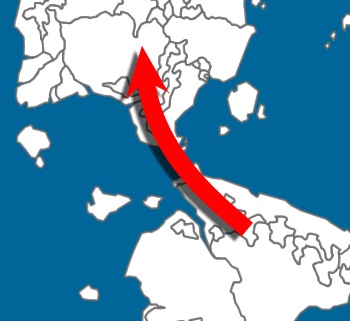Leaving Emer
There are many reasons to study the patterns of migration. The most relevant reason to students of the World of Teréth End, are to understand how languages are related. Yrūni languages have evolved along the dividing and merging paths of migration. These languages are believed to have emerged some 8,000 years ago with those that left the ghostly Emer. Nothing is known of the Eméreni, but their words are inscribed upon basalt structures still standing upon the abandoned continent, their meanings lost to time. Clues to the forgotten tongue may be found by tracing contemporary languages back to their source. To attempt this, it is important to know where each language and its people originated.Before 1 LR. Appearance of the mysterious Eméryr. Yrūn movements at the conclusion of the Second Age. The first Yrūni settlements of southern Lyrast. Rise of the Nāzar, Onnō, and Vuldir tribes.
The earliest Yrūn migrations occurred toward the end of the Second Age. The first year of the Lyrásti Reckoning is generally accepted as marking the start of Yrūn expansion into the lands beyond Emer. It is probably good to note at this point that there is not a sage or Immortal alive that can state without doubt that the Yrūn came from the Lost Land. The Exodus from Emer is an accepted theory based on the proximity of the first Yrūni settlements to the northern reaches of the Emeréni mainland. The first Dwürden to visit the primitive newcomers made no mention of boats or the mastery needed to fashion such vessels. The first Eylfae to observe the Yrūn dismissed them as “bestial” with an “intellect that is barely measurable”. The Eylfāe definition has probably not changed.
The Exodus theory invites further questions. Foremost among these are why did the Yrūn leave Emer? and why leave no one behind? The migration into Lyrast appears to have been abrupt and involving great numbers. Over the course of centuries a number of famous expeditions have explored the fringes of the Lost Land in search for answers to these questions. Though concrete explanations have not been found, there is evidence that a catastrophe of enormous scale may have driven its inhabitants away. Every century or so, intrepid pilgrims, outcasts, companies, or kingdoms attempt anew to colonize the ancient land but for whatever reason, their efforts do not succeed. Colonies are commonly found empty or missing during return trips.
As mentioned before, the people that appeared upon the shores of Lyrast did so in great numbers. What is unclear is whether they arrived as one group or in three separate waves. Shortly after their arrival in Lyrast, the Emeréni appear to have split into three groups: the Nāzar, the Onnō, and the Vuldir. Although little is known of these people and their languages, evidence has survived in the overgrown ruins of southern Lyrast and carved into ancient Dwürden records. The earliest Dwürdèni accounts of the Yrūn compare them to Ortor, who were already well-established in Teréðor by the end of the Second Age. Although Yrūni records from this time do not exist, stone ruins and artifacts are sometimes found that tie the “fledgling” Mortal race to this time and place. The division of the Yrūn into these three cultures is considered to be the beginning of the Second Migration.
